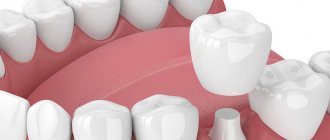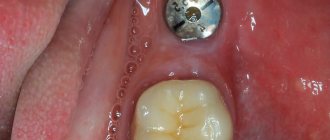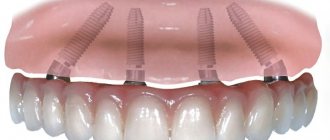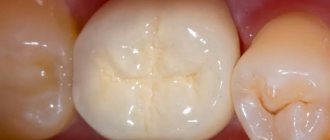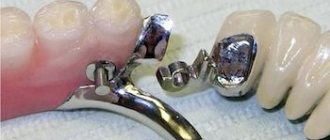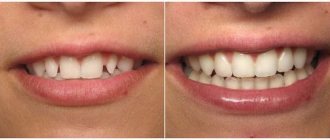In situations where a tooth breaks, it is severely worn out or seriously affected by caries, its destruction becomes significant and in these cases it can only be restored by resorting to prosthetics, in particular, temporary crowns will help to successfully solve the problem. Theoretically, you can get by with a filling, but in comparison with prosthetics, this solution loses in terms of reliability and durability. The filling gradually wears out, wears out and falls out under constant influence, so installing crowns will be the most correct solution. Yes, this procedure takes a lot of time, it involves first installing temporary crowns, but the result gives the expected quality. What are temporary crowns, what do such prostheses look like, why do people need them - this will be discussed below.
Purpose
During prosthetics, the procedure of tooth preparation is carried out and temporary crowns are necessary to protect the oral cavity from unwanted and even harmful influences; in addition, such crowns allow you to maintain the aesthetics of the dentition after grinding problem teeth. It should also be taken into account that when installed on the teeth, they relieve the patient from discomfort, since ground molars lose their main functionality, and also make it possible to correctly distribute the load during implantation.
How much does it cost to build a bridge?
The price for dental bridge crowns is determined by the cost category of the impressions, the design itself, installation and fitting services. There are the cheapest options available to most patients, but they will be significantly inferior to the more expensive ones in terms of operational and other characteristics.
On average, a budget bridge can be installed for 3 thousand rubles. Zirconium and metal-ceramic elements will cost 20 thousand or more, especially if implantation was performed.
The main factors on which the final installation cost depends
What affects the cost of orthopedic intervention:
- Material of manufacture. Plastic can be purchased several times cheaper than metal or ceramics. The last option with a zirconium dioxide frame is the most expensive.
- Application of implants. They can significantly increase the number of zeros on a check.
- Number of elements to install.
- Clinic location. Treatment in Moscow is much more expensive than in the regions.
- Pricing policy of a dental institution. This is due to market conditions, competitiveness, status and reputation of dentists.
Prosthetics allows you to restore lost teeth in a short time and without large material costs. When installing the structure, certain conditions must be met, and the patient must go through several successive stages. Unfortunately, despite the obvious advantages, bridges are not without their negative aspects. In addition, there are contraindications when it is not possible to restore the aesthetic appeal of a smile without harm to health in this way.
Advantages
Considering the somewhat lengthy treatment process, issues of the aesthetic appearance of the patient’s oral cavity acquire particular importance and significance; it is these considerations that dictate the need to use provisional crowns. Their key advantages are:
- no pressure on the supporting tooth, which allows the patient not to feel pain;
- such crowns provide the patient with excellent protection from gum growth and the effects of various microorganisms;
- the tooth does not shift;
- while wearing such a crown, the patient gradually gets used to the foreign body in his oral cavity;
- there is no violation of diction;
- to some extent, restoration of lost functions is carried out, albeit to a small extent.
Classification:
By purpose:
- Restorative;
- Abutment (used in bridges ; they replace not only a defect within the coronal part of a tooth, but also a missing tooth or several teeth).
By design features:
- Full (cover the prepared stump from all sides), partial (three-quarter, half-crowns) leave the outer surface of the crown open;
- Telescopic (double; used in removable prosthetics, the first cone-shaped is fixed on the stump, the second, restoring the tooth, is part of the removable part and is put on the first).
According to the material used:
- Metal (noble or base alloys);
- Non-metallic (ceramics, zirconium dioxide, plastic, composite);
- Combined (metal-ceramics, metal-plastic).
By fixation method:
- Cemented (for prosthetics of natural teeth or on implants);
- Screw (used only for prosthetics on implants - artificial analogues of natural roots, strengthened inside the bone tissue of the jaws).
By service life:
- Permanent;
- Temporary - provisional (used at the stages of manufacturing the final ones to protect the stump from irritants, restore contacts with other teeth and for aesthetic purposes, including to form the contour of the gums ).
Materials for production
The most common and popular material for making temporary crowns in dentistry is now plastic or composite. This is explained by a large number of their advantages:
- speed of hardening;
- ease of modeling a plastic crown;
- almost zero toxicity level;
- high strength of the finished product;
- the ability to perform crown adjustments at almost any time;
- short production time;
- relatively short wearing period.
These advantages, of course, serve as serious arguments in favor of plastic crowns, but one cannot ignore their disadvantages, namely:
- the possibility of complications due to penetration of microorganisms deep into the porous structure of the crown;
- poor resistance to dyes and color changes;
- the maximum service life does not exceed two years.
What are temporary dentures made of?
Until recently, temporary crowns were made only from plastic. However, such structures are not durable, quickly change color, and due to the porous structure, there is a risk of infection and microbes that affect the dental stump.
Therefore, more and more modern dental clinics are using polymer acrylic plastic and composite for short-term prosthetics.
Plastic crowns
- Plastic temporary dentures are made from a mass of hot or cold polymerization. They can withstand significant loads and allow you to reproduce many shades.
- For composite crowns, a composite material is used that is similar in all properties to filling materials. Easy processing, the ability to individualize the crown even over time and exceptional aesthetics are considered the distinctive features of such prostheses. (The photo shows samples of composite products).
In the classification of temporary structures, these are the two main types of metal-free dental crowns .
Methods, process and manufacturing steps
They can be produced with equal success both in the laboratory and in the dental office. The second option is good because it takes only two to three hours, but the shape and color of such a product will distinguish it from other teeth, but if the production takes place in a laboratory, the quality of the result will be higher, although it will take more time, approximately two or three days.
There are several methods for making crowns from plastic, in particular, the direct method, when the product is performed immediately in the dental chair according to the following algorithm:
- Taking an impression of the problematic tooth, its neighbors and the antagonistic jaw. The manufacturing material is softened silicone mass.
- After the silicone has hardened, the tooth is turned, on which a crown of both temporary and permanent properties will be installed.
- The material chosen for manufacturing is poured into the impression and it is placed on the ground tooth.
- Removing the impression, grinding and polishing the surface to bring it into proper shape, after which the final fixation of the prosthesis is performed using cement
This entire procedure lasts approximately one hour; the cement used to fix the prosthesis gradually dissolves under the influence of human saliva.
Accordingly, the indirect method is based on laboratory production of the product. This procedure is carried out by a technologist who gets his hands on a cast for making plaster blanks. Taking into account all the features of his existing models, he produces a prototype using special wax. As a result of such painstaking work, the prosthesis is made in full accordance with the patient’s jaw and is highly reliable.
Temporary dentures with a metal component
In restorative dentistry, tooth restoration takes several stages and a fairly long period of time. Especially when it comes to implants, sometimes it can take up to six months or more. For this reason, reliable temporary prostheses are essential.
During complex rehabilitation of a significant number of dental units with implants, metal-composite crowns as temporary structures. They are metal frames clad with a composite. Such prostheses are reliable and can withstand significant loads.
An alternative can be metal-plastic crowns - a metal frame lined with plastic - as auxiliary splinting devices during the implantation process with immediate load.
Restrictions on use and prohibitions
The use of temporary crowns is not always feasible and possible; there are certain restrictions on their use in such situations:
- It is not recommended to install prostheses for children under 12 years of age;
- if you are allergic to the materials used in prosthetics;
- when a patient experiences a phenomenon such as teeth grinding or bruxism;
- in cases of inflammation of the problem area of the oral cavity;
- if the patient has a deep bite;
- when identifying certain mental disorders.
For those who do not pay enough attention to oral hygiene, it is not recommended to install plastic dentures due to the fact that the porous structure of the material itself serves as a breeding ground for pathogenic bacteria.
A laboratory technician performs the following manipulations:
In addition to the traditional manufacturing method, there is also the so-called milling from ready-made blocks on a computer-controlled machine (CAD/CAM technology, for example CEREC, EVEREST). Using an optical system, an impression is taken (essentially scanned) either of the prepared area directly in the oral cavity, or of a model, then the data is transferred to a computer, where the image is processed by a special program, a model of the future restoration is built, which can be corrected, and then sharpened and finalized ( painted and glazed to give a shine comparable to natural). Now this is the most accurate way to create structures of various sizes and lengths (up to the entire dental arch), because human involvement and therefore possible inaccuracies are reduced to a minimum. The next step will obviously be the development of 3D printing technologies.
{SOURCE}
Indications for installation of prostheses
Installation of temporary plastic prostheses is carried out for the following indications:
- in situations where various types of damage to teeth visible to others have occurred, for example, when the enamel has darkened or the patient is not satisfied with their size;
- crowns are placed on chewing teeth in order to preserve a person’s ability to eat well and eat any food;
- before a complete reconstruction of the teeth is carried out, temporary crowns are placed on the ground molars in order to protect them from various external influences;
- to prevent overgrowth of the gum bed;
- to prevent displacement of teeth in a row;
- If you have periodontal disease, you cannot splint your teeth without temporary crowns;
- in order to restore the patient’s diction;
- for the purpose of covering implants when installing a permanent prosthesis.
When are provisional crowns used?
If the dental tissue has been destroyed by more than half, prosthetics cannot be avoided. Tooth filling is possible only for minor carious cavities. Making a permanent prosthesis in place of a previous tooth is a labor-intensive undertaking that takes (in addition to financial costs) a significant amount of time. Therefore, during orthopedic implantation, it is customary to install provisional crowns, which not only preserve the aesthetic appearance, but also make it easier for the patient to eat.
Designs for molars
Normal and nutritious human nutrition is impossible without chewing teeth, since the entire load during chewing food falls on them. Accordingly, as soon as the first problems with the condition of such teeth appear, you should immediately consult a doctor and arrange for the installation of dentures. However, it is necessary to understand that the choice of plastic crowns must be approached carefully and carefully; if you select unsuitable prostheses, this will not correct, but will only worsen the situation.
It is better to give preference to those prostheses that have the longest service life; we must not forget that the structures have to undergo very serious impacts and not the highest quality plastic can easily and quickly fail. Metal-ceramics and ceramics on paper look like a more preferable option, but, firstly, they are significantly more expensive, and, secondly, if you incorrectly calculate the bite or pressure force when installing them, then chips or cracks may form on the prosthesis, and this will cause serious inconvenience for the patient.
The indications for the use of these structures are the broadest:
Indications for the use of crowns
- Defects of the natural crown are more than half its size;
- Increased (inappropriate for age) abrasion of teeth; correction of jaw relationship (bite);
- Deep wedge-shaped defects are areas of triangular-shaped loss of hard tissue in the neck of the tooth (near the gums), weakening it and increasing the risk of complete breakage during chewing;
- Congenital anomaly of tooth shape (for example, underdevelopment or complete absence of enamel) or acquired (for example, after injury);
- Some congenital or acquired pronounced color changes that cannot be eliminated by bleaching (discolorities) are the consequences of injuries, medications used or materials for filling root canals;
- Tilting and/or protrusion of a tooth or a group of them when the patient refuses orthodontic treatment (orthopedic “movement”);
- Combining - splinting - teeth when they are mobile (the crowns are not made separately, but as a single block and are fixed at the same time);
- The need to improve the shape and protection of the tooth during removable prosthetics (creating pronounced convex contours that will hold the fixing elements and, along with them, the prosthesis itself);
- The presence of aesthetically unsatisfactory crowns (all-metal, combined with chips of the facing material or a gray-blue border, visible at the gingival margin when it decreases or thins).
Despite the variety of clinical situations in which the use of these structures is justified, the general rule is prosthetics in the early stages.
The process of removing temporary crowns
The very concept of “temporary crowns” means that after a certain period they must be removed, otherwise their functionality and appearance will no longer meet the requirements. How are such dentures removed? If metal ceramics were installed, then it must be sawed; this is not required for plastic, since this material does not have a high level of strength. First of all, the doctor will need to weaken the effect of the substances used to fix the prosthesis with the help of special drugs. Using a drill, a Copa apparatus and ultrasound, the process of gradual removal of the product is carried out. It is worth pointing out to patients that this procedure is painless and anesthesia is almost never required.
After the prosthesis is removed and the tooth is cleaned of the remaining fixing materials, the next temporary crown or a permanent one is installed. The decision in favor of one option or another must be made after consultation with a doctor. You also need to remember that a permanent crown is also limited in service life, but longer than a temporary one.
Service life
The service life depends on the manufacturing method and the characteristics of the materials used. Thus, for those manufactured by the direct method, the service life is 1-2 months. For laboratory ones – up to 1 year. For those models whose walls are reinforced with fiberglass or metal thread, as well as those made by milling, the service life can be 1.5-2 years. But, of course, if you take good care of the prosthesis - clean it regularly and do not subject it to heavy loads.
DENTAL PROSTHESIS ON 4 IMPLANTS - from RUR 170,000.
The price includes all procedures for installing Osstem implants (South Korea), including anesthesia and diagnostics.
Hurry up to sign up for a free consultation and fix your prices.
Call now or request a call
Opening hours: 24 hours a day - seven days a week
Care and how long can you wear them?
The duration of use of a temporary prosthesis is limited not only by its performance characteristics, but is also determined by its proper care. There is nothing complicated about this, care should consist of such simple things as:
- lower level of load on the area of the oral cavity where the prosthesis was installed;
- in this place, when brushing your teeth, you should perform gentler actions, without applying much force;
- After using dental floss, you should not pull it out, but carefully and calmly pull it out.
When answering the question of how long you can wear temporary dentures, you should remember that delaying this procedure does not justify itself. As soon as the permanent structure is ready, it is rational to replace the temporary prosthesis with it.
Advantages and disadvantages of dental bridges
Advantages of bridges in prosthetic dentistry:
- There is no need to wait for the installed structure to take root. That is, there is no need for osseointegration, which can last up to six months. It turns out that the adaptation process lasts quite quickly (up to 12 hours).
- This is the most economical option for restoring rows when individual units are lost than implantation.
- Modern technologies make it possible to obtain aesthetically attractive artificial teeth with full functioning. Hidden elements (fastenings, etc.) are not visible to others, so no one will even notice the medical intervention.
- The procedure has virtually no contraindications. A bridge is also placed in cases where implantation of an implant is not possible.
- Normal diction is maintained.
Weak sides:
- It is necessary to grind down the adjacent crowns remaining in the mouth. Very often, dentists resort to depulpation (removal of the nerve, cleaning and cementing of the canals).
- The normal load on the jaw bone is not fully restored. When a person chews food, the supports are loaded; the central part is practically not involved in this. As a result, the risk of bone tissue atrophy increases.
What to do if it falls out?
It happens that the installed temporary crown comes off. It is quite natural that patients are concerned about this situation and if it has happened, what to do next? First of all, there is no reason to panic; you should return it to its place yourself, fixing it with Vaseline or toothpaste and be sure to consult a dentist. The structure returned to its place on its own will, of course, not have the same strength and reliability, but it will still perform its basic functionality. It should also be remembered that it is better to remove the prosthesis before going to bed, this will avoid the potential serious consequences of its night loss.
Voice of the people
If we analyze the reviews of patients who resorted to installing plastic crowns, we can say that for many of them they became a real salvation. They are perfect for young girls who, due to their age, cannot yet install metal-ceramics and do not have complexes about their smile, for example, at school.
It is also noted that it is necessary to use plastic structures only on a temporary basis, since it is not possible to fit such a crown tightly onto the tooth, and it becomes a breeding ground for harmful microorganisms. Many patients say that as a temporary measure, such prostheses are almost an ideal solution to the problem, plus, their cost is quite affordable.
Comparative characteristics of artificial crowns
| Variety | Positive traits | Negative qualities |
| Metal (stamped and cast); | Stamped – gentle preparation (only the most protruding part of the crown around the circumference is ground); | Cast – hardness and bioinertness of noble alloys (does not interact with the body). |
| Combined (metal-ceramics) |
|
|
| Plastic and composite (currently used only as temporary) |
|
|
| Metal-free (ceramic and zirconium dioxide-based) |
| The relative fragility of pressed ceramics (IPS Emax technology, used only in the anterior part of the dental arches) |
Date of publication: September 20, 2020 Last update: September 22, 2022 © 2020 Professorial Dentistry “22 Century”. All rights reserved.
